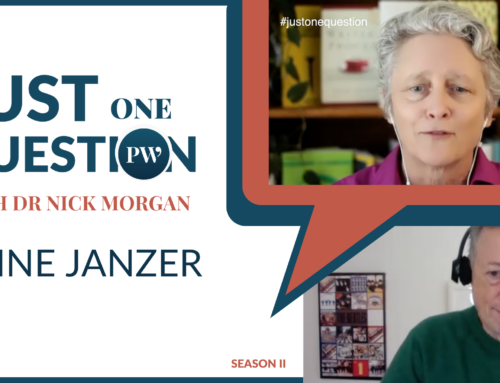I grew up in an era of print. We are now living in an era increasingly of video. What are the implications for public speakers and communications in general? Following are a series of axioms that I hope will provoke you to respond with insights of your own, in the (written) comments below.
Print is fast. Video is slow but speeding up. One of my pet peeves with video is how inefficient and slow it is for conveying information. The cliché says that ‘a picture is worth a thousand words’, but my experience is exactly the opposite. I find it painfully difficult to watch documentaries because it takes so long for the medium to impart the same amount of information I could devour in a brief article in a few minutes. But there is no question that video is speeding up. We are developing a video vernacular that moves much faster and more economically in 2022 than it did in, say, 1995. Movies from the 90s seem to crawl at a pace that makes them nearly unwatchable compared to today’s films – unless of course we are talking about emotional impact or visual beauty, and then time is not important, is it?
A recent study found that students could absorb as much information watching a video of a lecture at twice the speed (roughly 300 words per minute) of normal speech. It’s a surprising finding because the limit was thought to be 275 words per minute, based on earlier studies. But the research suggests that we have still faster video to come. (And of course there is a difference between the video vernacular at its most economical and effective versus merely filming a lecture.) Given that our information flow continues to increase in speed and volume, we’re going to need to be able to absorb still faster film speeds as video replaces print.
If it isn’t videoed, it hasn’t happened. Thanks to mobile phones, the amount of video of everything from baby’s first steps to successful climbs of Mount Everest is ballooning at a staggering clip. I have maybe a handful of pictures remaining from my childhood, and the earliest is probably one of me holding a toy train, a big grin on my face, at roughly age 2 — a moment for which I have no independent memory. My granddaughter’s image, at one year, is already recorded on daily pictures and videos that go way beyond anything possible or even imagined then. What will be the implications of this massive documentary deposit? Will she be more self-aware? How will it affect her memory of her childhood? Most youthful memories hitherto have begun with language acquisition – what will these early externally-recorded ‘memories’ do to her sense of her growing self?
Books are fast becoming souvenirs. As anyone who has signed books after a speech knows, the virtue in the book lies largely in its connection to the event and the temporary celebrity status earned by the author thanks to the bright lights, the stage, and the applause. Today, I’m delighted when someone tells me they have discovered one of my books through a recommendation or social media or the like. I’m giddy bordering on astonishment when a comment reveals that they have actually read the book. I am truly not cynical – just keenly aware that with more than a cool million new books published in the U. S. alone every year, and tens of millions of already-published books still in print, for someone to find yours is a heroic feat akin to Hercules finding a button underneath all that dirt in the Augean stables during his efforts there. Then, reading a book is a 6 – 12-hour relationship with the author. Who has time for that when a bulleted 5-minute summary is easily found on Facebook or some other platform?
I’m not sentimental. Indeed, I’m a technophile always looking ahead to new technology that can make our lives better, easier, simpler, cheaper or environmentally sounder. But what will we gain, and what will we lose, when video completely replaces the book as the way we humans communicate with one another through generations, space, and time?
Applied Cognitive Psychology (Murphy et al., 2022).









Because I believe that people are reading less, my next book will be shorter and will be supported by high-impact video. Instead of putting everything in written word, only a fraction of it will go in the book. Clients have told me that they often prefer to consume content in video form, especially when the video is high-quality. From a retention perspective, the ideal combination is video with subtitles. Studies show that when people read and listen at the same time, they retain more. I don’t think books will disappear, but I suspect (especially for content-related books) that their form will shift. Thanks for this!
Stephen — I’d love to check back in with you when you are ready to launch so we can follow up on this idea of a hybrid book/video arrangement. Many books launch, of course, with a tie to a website and further information, but that can feel like more work rather than less for the ‘reader’. So I’m curious as to how you get around the issue and offer a real alternative to someone who wants to absorb the information via video.
Your point is spot on. It needs to be easy (and better) for the reader. How to do that well is something I am still figuring out! I think one key is that the book needs to be whole and complete on its own. Plus, the segue from the book to video needs to be seamless (as mush as possible). One idea I am playing around with is putting QR codes in the book that will take the reader to a specific set of videos. This way you don’t need to fish through a whole website to get to the content you want. It takes you straight to the relevant videos. Another option is putting everything in the book AND everything in video and then people can choose their path. Keep reading the content or bop over to the website and watch videos. Not sure how well that would work. FYI, for my last book, I created a videobook. It is the entire book in video form. I read the entire book in front a green screen using a teleprompter and a video editor added graphics, animations, music, and more. My clients love it!
I am still a believer in the written word and in engaging people face-to-face. I will admit that my second book is shorter and very pointed. My goal is to get the message out to the people who can use the information.
Thanks, Diana — speaking to your audience, in whatever form, will never go out of style. I am glad to find another “believer in the written word.” Let’s exchange books!
Oi Nick Morgan, realmente, a motivação do leitor está mudando.
Os leitores estão mais interessados em assistir a vídeos do que em ler textos.
Existe até uma razão para isso.
As pessoas aprendem lendo, ouvindo, lendo, fazendo, etc.
E como a maioria das pessoas é visual, o vídeo tem grande aceitação e em detrimento do livro.
Já faz cerca de 10 meses desde que publiquei mais artigos escritos.
Agora eu posto vídeos.
Tenho mais de 300 no LinkedIn.
Fiz alguns testes da seguinte forma:
Peguei artigos que fiz há alguns meses e os transformei em um vídeo.
Visualização com vídeo por quase quatro vezes mais.
Faço vídeos editados com o Vegas Pro e adiciono fotos.
Se quiser ver meus vídeos, será um prazer: @elazierbarbosa
Um abraço caloroso do seu leitor assíduo.
Hi Nick Morgan, really, reader motivation is changing.
Readers are more interested in watching video than reading text.
There is even a reason for that.
People learn by reading, listening, reading, doing, etc.
And since most people are visual, the video has great acceptance and the book’s detriment.
It’s been about 10 months since I’ve published any more written articles,
Now I post videos. Have 300+ on LinkedIn.
I did some tests as follows:
I took articles I made a few months ago and turned them into a video,
Viewing with video by almost four times longer.
I make edited videos with Vegas Pro and add photos.
If you want to see my videos, it would be my pleasure: @elazierbarbosa
A warm hug from your assiduous reader.
Thanks, Elazier — I’m impressed that you have made the transition to video. I love both, but find it hard to give up print!